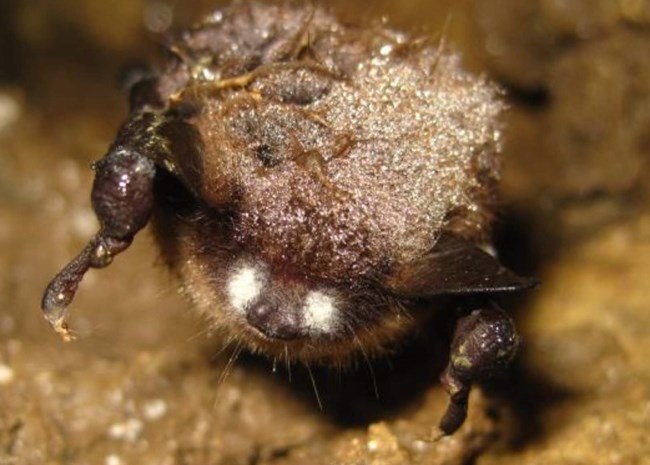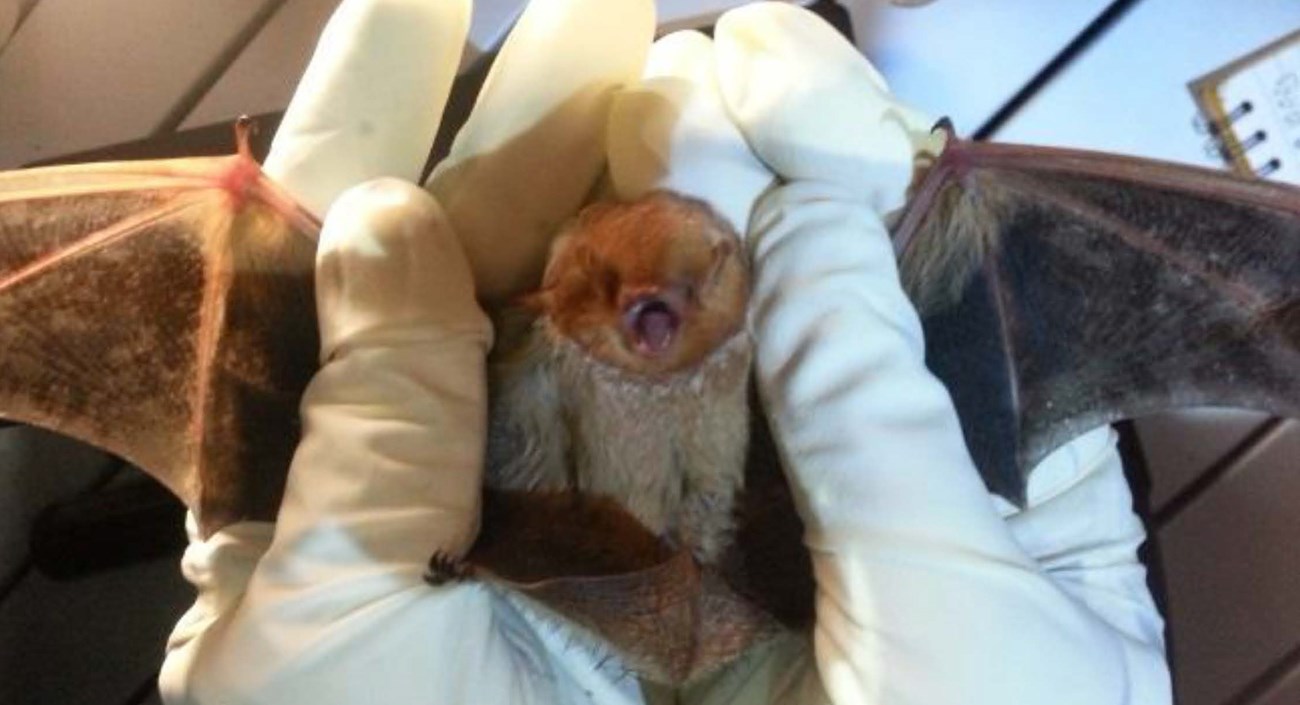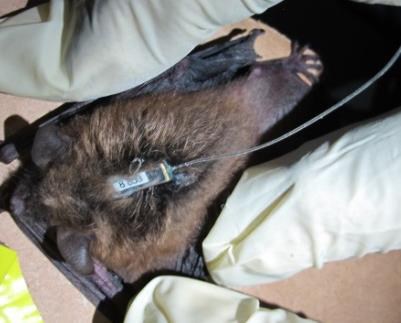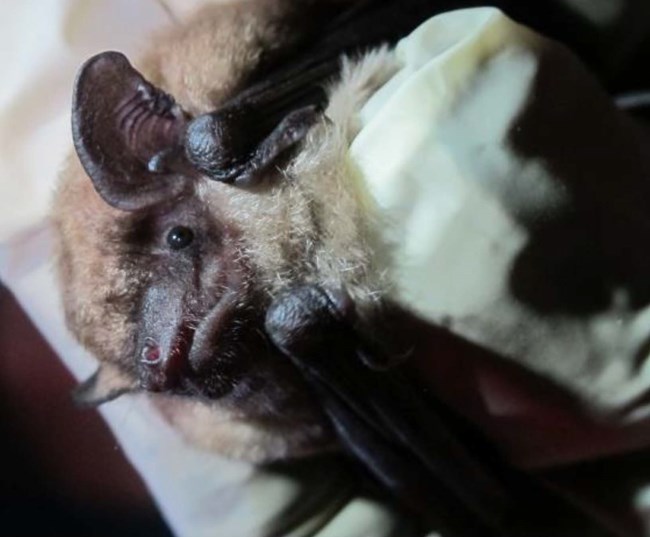Last updated: October 16, 2017
Article
Bat Projects in Parks: Effigy Mounds National Monument
Summary
Nursery roost habitat survey, netting bats, genetic testing for the fungus that causes WNS, surveying for bat species, tracking bats to roosting sites, year around acoustic monitoring of bats. Tracking bat genetics.
PI: Rodney Rovang
Effigy Mounds National Monument utilized the 2016 WNS funds to conduct a third year of bat monitoring. The objective of this agreement is to fund a survey of the bat species utilizing the available habitat at Effigy Mounds National Monument (EFMO) during the growing season. The immediate goals of this project are 1) to assess the bat community at EFMO for evidence of exposure to Pseudogymnoascus destructans, the fungus that causes White-Nose Syndrome (WNS); 2) to determine whether Indiana bats (Myotis sodalis), a federally endangered species, occur within EFMO; 3) to document and describe the bat assemblage present in EFMO; 4) to document and describe the temporal diversity of the bat assemblage that occurs within EFMO; and 5) to create a baseline against which any future bat surveys in eastern Iowa may be compared. Our results to date for each objective are: 1) ~5% of bats sampled (2014 and 2015 samples) have tested positive for exposure to Pseudogymnoascus destructans and we have >100 samples from 2016 that require molecular analysis that will commence in September 2106; 2) we have no evidence to suggest the presence of Myotis sodalis in Effigy Mounds National Monument; 3) Present species are, in order of abundance of capture through mist-netting, Myotis lucifigus, Myotis septentrionalis, Eptesicus fuscus, Lasiurus borealis, Perimyotis subflavus, Lasiurus cinereus, and Lasionycteris noctivagans; 4) temporal shifts in community structure do appear with a detected increase in Myotis lucifugus from early summer to late summer and corresponding decreases in Myotis septentrionalis and Eptesicus fuscus while other species remain relatively consistent through time; and 5) 2016 represents a second year for constructing a baseline. We caught 92 bats during 2015 and 184 in 2016. There were a total of 42 net nights in 2015 and a total of 53 net nights in 2016. The resulting Catch Per Unit Effort (CPUE) was 2.19 bats per net night in 2015 and 3.47 bats per net night in 2016.

Photo by Jeanette Muller
Little Heroes
Imagine being able to fly, find food with your voice and sleep the winter away. If you are a little brown bat (Myotis lucifugus), you can do all of this and more. Earth's 1,300 bat species are critical for ecosystems and human economies as pollinators, pest control, and seed dispersal. Tropical fruit-eating bats disperse seeds, restoring damaged rainforests and accounting for up to 95% of forest regrowth on cleared tropical forest land.
In the Midwest, bats play a vital role in agriculture and our health. Our bats are insectivores. In the southern US, the Mexican freetailed bat (Tadarida brasiliensis) feeds on migratory insect pests, such as corn ear-worm moths and army cut-worm moths before they can reach the Midwest and impact crops. Some colonies eat 250 tons of insects every night.
There is currently no known way to prevent the spread of WNS. However, there has been research into treating infected bats: 75 infected little brown bats in Missouri were treated with Volatile Organic Compounds (VOC) given off by a common bacterium and did recover. The VOC from the bacteria inhibits growth of the Pd fungus. Although it shows some promise, the effect of VOC on cave environments is not known and wide scale treatment efforts may not be feasible, so more study is required.
The spread of WNS in bat populations across North America has prompted the National Park Service and other groups to gather as much data as possible on both affected and unaffected populations of bats. As part of this effort, Effigy Mounds National Monument has received funding to study bats in the park. Since 2014, we have worked with the University of Dubuque to document the bat species using the monument as summer habitat, identify areas of preferred habitat, and to assess for exposure to Pd. Study techniques included mist netting, radio telemetry, and acoustic monitoring.

NPS Photo/Sarah Knight
Bat research in 2016
Since being detected in upstate New York in 2006, the bat disease known as white-nose syndrome (WNS) has been found across the Eastern, Central and now, even the Western US. The disease has killed upwards of 90% of vulnerable bat populations. It is caused by a cold-loving fungus, Pseudogymnoascus destructans (Pd). The fungus is thought to have been introduced to the Americas from Europe. Hibernating bats with WNS are awakened and disturbed by the fungus growing on and damaging their skin. Because they are not conserving energy by hibernating, the bats run out of energy and die.
Pd stops growing in warm weather, although the spores can still be spread, hitch-hiking long-distances on migratory species of bats, or on people and equipment that have been in infected caves. Bats that survive WNS during the winter may show scars and can recover in warmer weather as they feed.
Mist netting involves putting up sets of fine nets on poles that are eight meters tall. On each netting night, between three and six nets were set up at various locations. The bats have trouble detecting the net, and some fly into it and become entangled. Captured bats are identified, sexed, weighed, measured, swabbed, and then released. The swab is later analyzed to determine if the fungus, Pd, is present.
During mist netting, some female northern long-eared bats (Myotis septentrionalis) were affixed with radio transmitters. In the following days, radio-tracking was conducted to locate their day-roots. Bats were tracked to large and small trees, both live and dead, and roosts included tree species such as oak, box elder, hickory, and elm. At roosting sites, we noted canopy cover, tree density, tree species, and the height and diameter or trees. This information will help us determine if some habitats are more suitable for northern long-eared bats.

NPS Photo/Kat Busse
Through mist netting we have confirmed that the park is host to seven species of bats, including the northern long-eared bat, a federally threatened species. Our other bat species include: big brown (Eptesicus fuscus), little brown, hoary (Lasiurus cinereus), red (Lasiurus borealis), silver-haired (Lasionycteris noctivagans) and tri-colored (Perimyotis subflavus) bats. This included all of the species that are possible to find in this part of the United States, so their presence here shows just how important Effigy Mounds National Monument is as a habitat for bats.
As a result of this research, two U.D. field technicians presented a paper about Effigy Mounds bat ecology before a panel of 13 judges at the International Junior Forester Competition, an international contest in Russia, and won third place. In addition, the research has resulted in 18 poster and platform presentations at 11 scientific conference since 2014. A NPS biological technician also presented a poster at the Central Plains Society of Mammalogists meeting in October 2016, about long-term acoustic monitoring efforts at Effigy Mounds.

NPS Photo/Kat Busse
Fun Bat Facts
- Less then 0.5% of bats contract rabies. Rabid bats often die quickly and are rarely aggressive or transmit the disease.
- Most perceived "bat attacks" are bats hunting insects near us.
- Bats found on the ground after a storm may be tree-roosting species, nursing mothers or young bats.
- Some pregnant or nursing mother bats may eat up to their body weight in insects each night.
- Plants pollinated by bats include: avocado, dates, figs, and cashews.
- Little brown bats can catch over 1,000 insects in on hour and may live past 30 years.
- Little brown bats and big brown bats will utilize both natural and man-made structures.
- Crops protected from pests by bats include: chocolate, walnuts, rice, corn, sugar, coffee, pecans, and almonds.
More Information
For more information, contact the Natural Resources Manager, Rodeny Rovang at 563-873-3491 ext. 141 or e-mail us.
